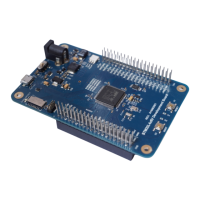DocID024597 Rev 3 291/1693
RM0351 Peripherals interconnect matrix
294
External clock LSE can be used as input to general-purpose timers (TIM2) on TIM2_ETR
pin, see Section 27.4.19: TIM2 option register 1 (TIM2_OR1).
Active power mode
Run, Sleep, Low-power run, Low-power sleep.
9.3.8 From RTC, COMP1, COMP2 to low-power timer (LPTIM1/LPTIM2)
Purpose
RTC alarm A/B, RTC_TAMP1/2/3 input detection, COMP1/2_OUT can be used as trigger to
start LPTIM counters (LPTIM1/2).
Triggering signals
This trigger feature is described in Section 30.4.5: Trigger multiplexer (and following
sections).
The input selection is described in Table 166: LPTIM external trigger connection.
Active power mode
Run, Sleep, Low-power run, Low-power sleep, Stop 0, Stop 1, Stop 2 (LPTIM1 only).
9.3.9 From timer (TIM1/TIM2/TIM3/TIM8/TIM15) to comparators
(COMP1/COMP2)
Purpose
Advanced-control timers (TIM1/TIM8), general-purpose timers (TIM2/TIM3) and general-
purpose timer (TIM15) can be used as blanking window input to COMP1/COMP2
The blanking function is described in Section 19.3.7: Comparator output blanking function.
The blanking sources are given in:
• Section 19.6.1: Comparator 1 control and status register (COMP1_CSR) bits 20:18
BLANKING[2:0]
• Section 19.6.2: Comparator 2 control and status register (COMP2_CSR) bits 20:18
BLANKING[2:0]
Triggering signals
Timer output signal TIMx_Ocx are the inputs to blanking source of COMP1/COMP2.
Active power mode
Run, Sleep, Low-power run, Low-power sleep.
9.3.10 From ADC (ADC1) to ADC (ADC2)
Purpose
ADC1 can be used as a “master” to trigger ADC2 “slave” start of conversion.
In dual ADC mode, the converted data of the master and slave ADCs can be read in
parallel.

